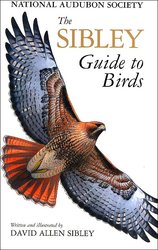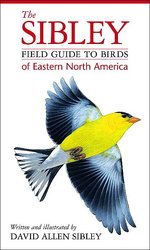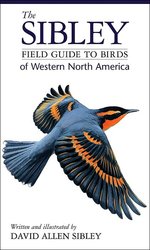Reviewed by Grant McCreary on April 6th, 2007.
There’s now a second edition of The Sibley Guide. Here’s my review.
When a particular brand-name product becomes widely used and well known sometimes people will refer to all similar items by that particular brand-name. Examples include facial tissues (Kleenex), ear swabs (Q-tips), and softdrinks (Coke, at least in the south). This hasn’t quite happened with North American field guides to birds, but the Sibley guide has become so popular that it is widely referred to simply as “Sibley” instead of the more generic “field guide”. I’ve found that I and others I have birded with often say something like “Do you have a Sibley handy?” or “Let me look in my Sibley”. I have never heard anything similar for any other field guide. The reason is simple. The Sibley guide, combined with the appropriate regional Sibley, is the best available field guide to North American birds.
There are actually three Sibley field guides. The first one that was published covered the entire continent (hereafter referred to as the “large” guide). A few years later came two smaller regional guides that covered the eastern and western halves of the continent (“small” or “regional” guides). To me the “large” and “small” Sibleys are not in direct competition, but instead complement each other. Therefore, all will be covered in this review.
The Large Sibley Guide
The first thing that you will notice about the large guide is
that it is, well, large. It is much larger than other North
American field guides (but still smaller than such behemoths as
Hilty’s Birds of Venezuela and
other Central and South American guides). It also weighs in at a
hefty 2.7 pounds (1200 grams).
But once you open the book the wonderful illustrations will make you forget about everything else. To my eye they are over all the most pleasing and accurate of any NA field guide. And there are a lot of them! Each species gets at least four illustrations. Included is just about every plumage variation for each species, broken down by sex, age, season, and geographical variation. Additionally, this is the only guide I’m aware of that includes an illustration of nearly every bird in-flight. Most of them even have at least two in-flight images – one that shows the upper side of the wings and back and one that displays the underside. However, some of the exotics (including finches and parrots) do not have all the illustrations listed above.
Sibley points out the most important features of the bird using lines and notes. This is similar to the arrows first utilized by Roger Tory Peterson in his guides but is even more useful due to the included notes. Thus, you are not just shown where to look, but what to look for. Another fantastic feature is that each label for a seasonal plumage (breeding, nonbreeding, 1st Winter, juvenile, etc) includes the date range, in months, that plumage is held. Of course birds in real life don’t always keep the schedule that they are “supposed” to, but this is still a very useful feature. I find it hard to believe that no other NA guide does the same.
The species accounts also include the size of the bird (length and wingspan in inches and weight in ounces and grams), some text, a description of the voice, and a range map. There is usually two birds to a page, with a couple of lines of text at the very top giving a brief overview of the two species. Then each species has a couple additional lines of text intended to help with identification. There is no mention of breeding habits, additional biological information, or the like, except when it aides identification.
The range maps use different colors to indicate breeding, wintering, and permanent resident status. There is also a different color used to indicate the normal path of migration. Additionally, single green dots indicate vagrancy records outside the normal range.
The way the species are laid out leaves an ample amount of whitespace on the page. It seems that either the size of the illustrations could have been increased, or the overall size of the book decreased. On the other hand, the extra whitespace decreases clutter, gives the illustrations room to breathe, and also allows for notes to be written in the book. Therefore, the design could either be a positive or negative depending on the user.
810 species are included, which is 157 less than the fifth edition of the National Geographic guide. Although it would be nice to have more species included, most of the ones that are missing have been only single records, Alaskan vagrants, or those suspected to be extinct. The species that are covered should be sufficient for the vast majority of North American birders.
Also included is a basic introduction and instructions on how to use the book. Variations in appearance is given relatively extensive treatment, including geographic differences, aberrant plumages, hybrids, and more. The bird topography section is very extensive and detailed (sixteen illustrations are used!).
The main drawback of this version is the size. Not many people would carry this into the field. But that’s where the regional guides come in…
Eastern and Western Guides
These are true field guides, and are likely small enough to fit into at least one pocket of whatever you’re wearing. The eastern guide covers the US and Canada east of the Rocky Mountains and includes 650 species. The western version covers 703 species from the Rocky Mountains westward.
There had to be other changes, in addition to reducing the number of species, to get these guides down to a manageable size. The illustrations are slightly smaller and there are fewer of them. Some species loose maybe one plumage, but some don’t lose any at all. Again, nearly every species is shown in-flight from two angles. I have not noticed any changes to the images other than the resizing, nor am I aware of any new ones. The amount of whitespace also seems to have been decreased.
But not everything has been reduced. The text, for example, has been greatly expanded upon. The species’ relative abundance (common, uncommon, etc) is now given at the beginning of each account. Granted this status has to be a simplification due to the vast area covered, but this addition is a definite improvement. Some additional breeding, habitat, and behavioral information are also given in most cases, along with the identification information. However, not all of the information from the large version has been included, so you must reference both to get the most complete picture possible.
The range maps in the small guides have also been updated. In addition to the updates to the range limits, the treatment of vagrancy has also been improved. While single dots are still used in some cases, the area in which the species is considered rare is now shaded with a drab greenish color.
Therefore, the advantages of the regional guides are their portability, increased text, and updated range maps. But the size constraint means that the number and size of the illustrations have been sacrificed.
Get these guides!
The Sibley guides are the current standard for North America. I would recommend that every birder in the US and Canada have a copy of the large Sibley for reference. It is also a good choice for those outside these countries that are interested in North American birds. Additionally, I would highly recommend the appropriate regional guide to use as a primary field guide. They are the only ones I have ever taken into the field with me, even though I have all the major guides for NA.
This pretty much sums it up:
No book published in this century (and only one in the last) has been so catalytic a tool for bird identification. If you spend part of your life studying birds, you cannot be without the Sibley Guide.
– Pete Dunne in his Essential Field Guide Companion
Head over to David Sibley’s website for a gallery, interviews, and identification notes (including a plate of the Ivory-billed Woodpecker!).
Disclosure: I get a small commission for purchases made through links in this post.





[…] here. The number of pictures per species in this guide is less than in the National Geographic and Sibley guides. Nevertheless, it does compare favorably to other recent photographic guides, and the […]
[…] made by Peterson and Floyd. Contrary to Schaffner. I became a birder, in large part, due to The Sibley Guide to Birds. After I started looking for and identifying birds, I wanted to learn all I could about these […]